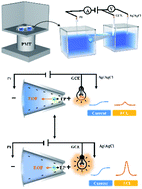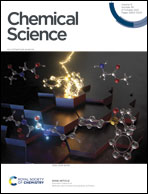Design of an electrochemiluminescence detection system through the regulation of charge density in a microchannel†
Abstract
Rare electrochemiluminescence (ECL) sensors have been developed based on the direct regulation of ionic current because it is difficult to establish a relationship between ionic current and ECL reporting. Ionic current can be adjusted by the effective radius and charge density of a functionalized microchannel and is frequently adopted to develop electrical sensors. Here, we show a novel ECL sensing platform that combines the microchannel-based electrical sensing technology with an ECL reporting system for the first time. The target regulated the effective radius and charge density of a microchannel which in turn adjusted the ionic transport in it and finally caused the change of ECL reporting of a tris(1,10-phenanthroline)ruthenium(II)/tripropylamine system. The developed system has already been applied to detect aflatoxin B1 for demonstration. This configuration separated the target sensing and reporting reactions to achieve direct regulation of ECL reporting by ionic current and expanded the application of the ECL detection technology to microanalysis.



 Please wait while we load your content...
Please wait while we load your content...